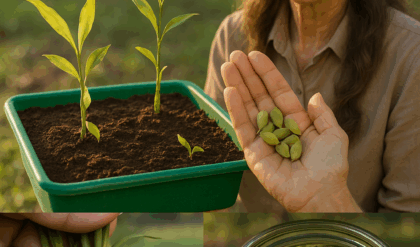What if you could transform a discarded plastic bottle into a mini garden, yielding crisp, nutrient-packed bean sprouts in just three days? Bean sprouts, the crunchy stars of stir-fries and salads, are a superfood bursting with vitamins, antioxidants, and enzymes, and growing them at home is fast, cheap, and eco-friendly. Using a simple plastic bottle, you can harvest fresh sprouts for pennies, without fancy equipment or outdoor space. Curious about this ingenious gardening hack? Dive into this step-by-step guide to learn how to grow bean sprouts in plastic bottles, discover their health benefits, and unlock a sustainable way to enjoy vibrant, homegrown greens year-round.

Why Grow Bean Sprouts at Home?
Bean sprouts, typically from mung beans (Vigna radiata), are a nutritional powerhouse, offering vitamin C, folate, and protein in a low-calorie package. Store-bought sprouts can cost $3-5 per pound and risk contamination, but homegrown sprouts are fresher, safer, and ready in just 3-5 days. Using recycled plastic bottles, this method costs under $1, reduces waste, and fits any space—kitchen counters, apartments, or even dorms. As praised for its “effortless green magic,” this technique delivers a steady supply of sprouts for salads, sandwiches, and more. Here’s how to make it happen.
Materials Needed
🪴 Plastic Bottle: 1-2 liter clean, clear plastic bottle (e.g., soda bottle) with cap.
🌾 Seeds: 2-3 tablespoons mung bean seeds (organic, non-treated, from a trusted supplier).
💧 Water: Clean, room-temperature water for soaking and rinsing.
🛠️ Tools: Scissors or a sharp knife, cheesecloth or fine mesh, rubber band, bowl for soaking.
🌞 Optional: Spray bottle for misting, labels for tracking.
Step-by-Step Guide to Growing Bean Sprouts
🌾 Source Quality Seeds: Purchase organic mung bean seeds from a reputable nursery or health food store, ensuring they’re untreated for sprouting. Each tablespoon yields about 1 cup of sprouts, as noted for “bountiful harvests.”
🪴 Prepare the Bottle: Rinse a 1-2 liter plastic bottle thoroughly, removing labels. Using scissors, poke 6-8 small holes (1-2 mm) around the sides for drainage and airflow, avoiding the bottom to retain some moisture. Keep the cap for sealing.
🌱 Soak the Seeds: Place 2-3 tablespoons of mung bean seeds in a bowl, cover with 1 cup of room-temperature water, and soak for 8-12 hours (overnight). This jumpstarts germination, praised for “sprouting speed.”
💧 Start Sprouting: Drain soaked seeds and transfer them to the bottle. Secure a piece of cheesecloth or fine mesh over the bottle’s mouth with a rubber band to allow airflow while keeping seeds inside. Place the bottle on its side in a dark, warm spot (70-80°F), like a cupboard, tilting slightly (cap end up) to let excess water drain through holes.
🌞 Rinse and Drain: Twice daily (morning and evening), pour 1 cup of water into the bottle through the mesh, swirl gently to rinse seeds, and drain completely through the holes. Return the bottle to its tilted, dark position. This prevents mold and promotes growth, as noted for “crisp, clean sprouts.”
🍃 Harvest in 3 Days: By day 3-5, sprouts should be 1-2 inches long with white tails and small yellow-green leaves. For greener sprouts, place the bottle in indirect sunlight for 6-8 hours on day 3 to develop chlorophyll. Remove sprouts, rinse in cold water to shed seed hulls, and pat dry with a clean towel. Yield: 2-3 cups per tablespoon of seeds.
🧊 Storage: Store sprouts in a breathable container lined with paper towels in the fridge for up to 5-7 days. Rinse every 2 days to maintain freshness, ensuring “vibrant crunch.”
Tips for Success
🌱 Choose the Right Seeds: Use mung beans for classic sprouts; adzuki or lentil seeds work too but may take 4-6 days. Avoid treated seeds meant for planting.
💧 Maintain Hygiene: Sterilize the bottle with hot water and vinegar before use to prevent bacterial growth, a key tip for “safe sprouting.”
🌞 Control Light: Keep sprouts in darkness for white, tender tails; brief sunlight on the final day enhances flavor and nutrition.
🐞 Prevent Mold: Ensure thorough draining and good airflow; if mold appears (fuzzy or slimy growth), discard and start anew with a cleaner bottle.
🌿 Batch Sprouting: Use multiple bottles, starting a new batch daily for a continuous supply, as celebrated for “non-stop greens.”
Health Benefits of Bean Sprouts
🩺 Nutrient-Dense: Sprouts offer 23 mg of vitamin C, 43 mcg of folate, and 2g of protein per 100g, supporting immunity and cell repair, noted for “packed nutrition.”
🛡️ Antioxidant Power: Phenolic compounds reduce oxidative stress, lowering chronic disease risk, as studies highlight for “cellular health.”
🥗 Aids Digestion: Enzymes like amylase improve nutrient absorption, while 2g of fiber per 100g promotes gut health, praised for “digestive ease.”
🌟 Supports Weight Management: Low in calories (30 kcal per 100g), sprouts add bulk to meals, enhancing satiety, lauded for “healthy fullness.”
Creative Uses for Bean Sprouts
🥗 Salads and Wraps: Toss sprouts with cucumber, avocado, and sesame dressing for a crunchy salad or wrap filling.
🍲 Stir-Fries: Sauté with garlic and soy sauce for a quick, nutrient-rich side, perfect with rice or noodles.
🥪 Sandwiches: Layer sprouts in sandwiches for a fresh, vitamin-packed crunch.
🥤 Smoothies: Blend a handful with spinach and pineapple for a nutrient boost, masking their mild flavor.
Precautions for Safe Sprouting
⚠️ Handle carefully:
- Hygiene: Wash hands, bottle, and seeds thoroughly to avoid contamination, as sprouts are prone to bacteria like E. coli.
- Seed Quality: Use organic, sprouting-specific seeds to ensure safety and viability.
- Allergies: Test a small amount to avoid reactions, though rare, ensuring digestive comfort.
- Storage: Discard sprouts with off odors or sliminess; consume within 7 days for freshness.
- Medical Conditions: Consult a doctor if immunocompromised, as raw sprouts carry a low risk of bacterial growth.
Amplify Benefits with a Healthy Lifestyle
🏃♂️ Pair sprouting with a nutrient-rich diet of fruits, vegetables, and lean proteins to enhance wellness. Regular exercise, like a 30-minute walk, boosts energy for gardening tasks. Drink 8-10 glasses of water daily to support digestion and hydration.
Prioritize 7-8 hours of sleep for recovery and practice stress-relief techniques, like meditation, to reduce inflammation and complement the sprouts’ benefits.
Start Sprouting Today
Growing bean sprouts in plastic bottles is a fast, eco-friendly way to enjoy fresh, nutrient-packed greens in just 3 days. With a recycled bottle, a handful of seeds, and minimal effort, you can create a sustainable mini garden that elevates your meals and health. Ready to unlock this sprouting magic? Grab a plastic bottle, sow some mung bean seeds, and harvest crisp sprouts today, transforming your kitchen into a hub of vibrant, homegrown goodness.
How to Grow Bean Sprouts in Plastic Bottles
Materials Needed
- Plastic Bottle: 1-2 liter clear bottle with cap
- Seeds: 2-3 tbsp organic mung bean seeds
- Water: Room-temperature for soaking/rinsing
- Tools: Scissors, cheesecloth/mesh, rubber band, bowl
- Optional: Spray bottle, labels
Step-by-Step Guide
- Source Seeds: Buy organic mung bean seeds for sprouting.
- Prepare Bottle: Rinse bottle; poke 6-8 small holes in sides.
- Soak Seeds: Soak 2-3 tbsp seeds in 1 cup water for 8-12 hours.
- Start Sprouting: Drain seeds, add to bottle, cover with mesh, place on side in dark, warm spot (70-80°F), tilting cap up.
- Rinse and Drain: Rinse with 1 cup water twice daily, draining fully.
- Harvest: Harvest 1-2 inch sprouts on day 3-5; optional sunlight for 6-8 hours on day 3 for greener sprouts. Rinse and dry.
- Storage: Store in breathable container in fridge for 5-7 days; rinse every 2 days.
Tips for Success
- Use mung beans for 3-day sprouts; adzuki/lentils take longer.
- Sterilize bottle with vinegar to prevent bacteria.
- Keep in dark for white sprouts; brief light for flavor.
- Drain thoroughly to avoid mold; discard if fuzzy/slimy.
- Start daily batches for continuous supply.
Precautions
- Wash hands/bottle/seeds to avoid contamination.
- Use sprouting-specific seeds.
- Test for allergies before consuming.
- Discard off-smelling sprouts; use within 7 days.
- Consult doctor if immunocompromised.





